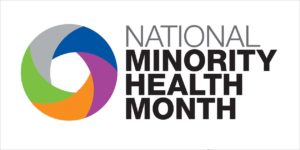
April is National Minority Health Month. Learn what you, your family, and community can do to get active and stay healthy.
Physical activity is one of the best things people can do to improve their health. Yet, too few Americans get the recommended amount of physical activity. Only 1 in 4 adults and 1 in 5 high school students fully meet physical activity guidelines for aerobic and muscle-strengthening activities. These numbers are even lower among adults in some racial and ethnic minority populations.
Physical activity promotes health and reduces the risk of chronic diseases and other conditions that are often more common and more severe among racial and ethnic minority groups. Physical activity also fosters normal growth and development in children, improves mental health, and can make people feel better, function better, and sleep better.
The Physical Activity Guidelines for Americans outlines the amounts and types of physical activity needed to maintain or improve overall health and reduce the risk of chronic disease. The guidelines recommend that adults each week get at least 150 minutes of moderate-intensity aerobic activity, such as a brisk walk that makes your heart beat faster. You could get this amount many different ways including a 22-minute walk each day or a 30-minute walk five days a week. Every little bit counts.
Preschool-aged children should do physical activity every day throughout the day for healthy growth and development. Children and adolescents starting at age 6 should participate in at least 60 minutes of moderate-to-vigorous intensity physical activity daily. Remember that children imitate adults. You can start by adding physical activity to your own daily routine and encouraging your child to join you.
Communities can create easy and safe options for physical activity that can help every American be more active where they live, learn, work, and play. The Racial and Ethnic Approaches to Community Health (REACH) program is one of the only CDC programs that focuses on reducing chronic disease for specific racial and ethnic groups in urban, rural, and tribal communities with high disease burden across the United States. Since 1999, REACH has demonstrated that locally based and culturally tailored efforts can be effective in closing health gaps. Read some examples of REACH communities that have made it easier for people to be active:
Parks Rx Program: The University of Alabama Birmingham’s (UAB’s) Minority Health & Health Disparities Research Center teamed up with 23 health care providers to develop Parks Rx. Using Parks Rx pads (available in both Spanish and English), providers prescribe physical activity to their patients and direct them to the Parks Rx website. The website includes an interactive map where patients can search by zip code to find more than 140 local parks and green spaces for physical activity. Learn more.
Pow Wow Sweat: “Eat. Do. Honor. The qhest life is the best life because it’s life based on our long-held traditions of health and wellness.” –Qhest Life
To increase opportunities for physical activity in Native American communities, the Coeur d’Alene tribe in Plummer, Idaho, launched the Pow Wow Sweat program with a series of aerobic videos featuring traditional dances with a modern twist. The tribe provides no cost ready-to-use videos online and on DVD for people to use in their own communities. Learn more.
